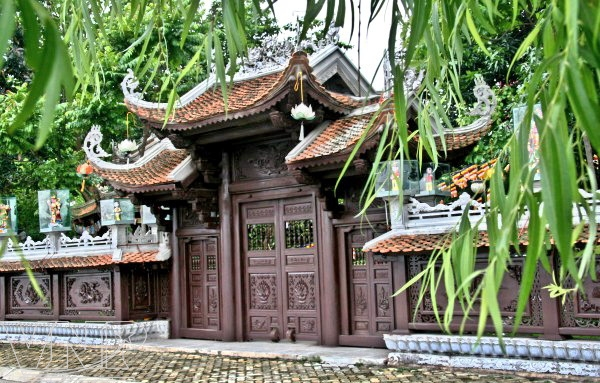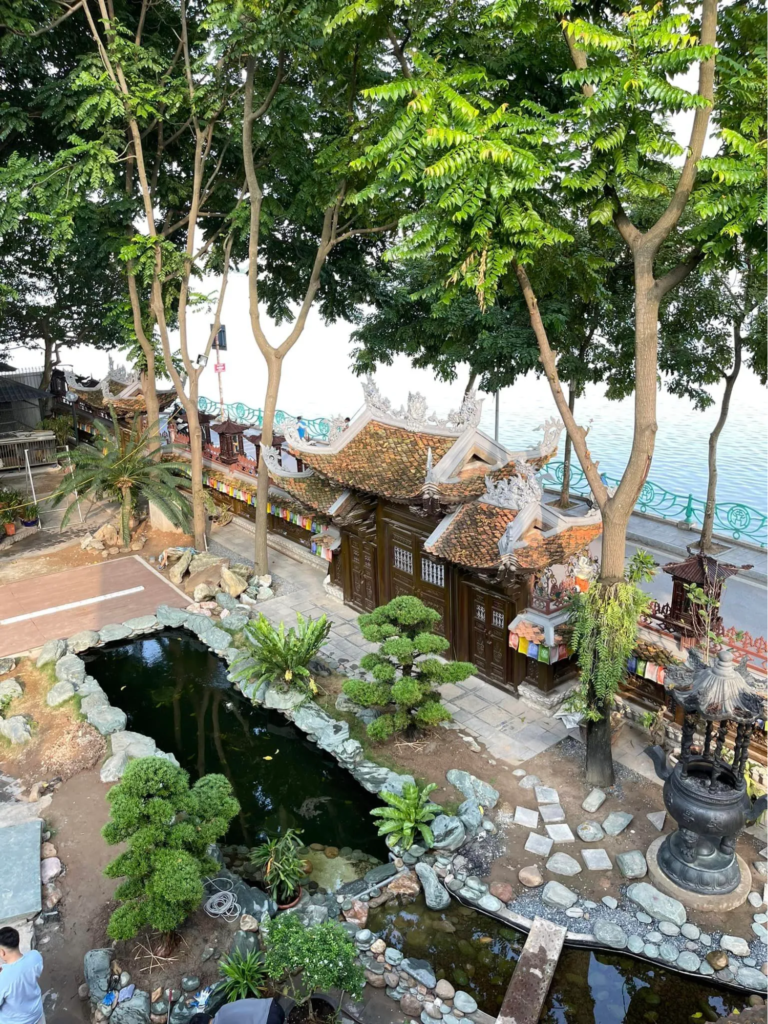Discover the history, architecture, and cultural significance of Van Nien Pagoda, an ancient Buddhist temple in Hanoi. Let’s find out with Lily’s Travel about what to expect, key highlights, and tips for visiting this serene spiritual destination.

Introduction to Van Nien Pagoda
Located in Tay Ho District of Hanoi, Van Nien Pagoda is a symbol of Vietnam’s rich spiritual history and architectural heritage. Nestled along the peaceful shores of West Lake, the pagoda provides visitors with a serene escape from the busy city life.
Renowned for its ancient origins and spiritual importance, Van Nien Pagoda is a must-visit for anyone interested in Buddhism, Vietnamese history, or traditional architecture. With its long-standing presence over the centuries, this pagoda continues to draw both tourists and locals, offering a place for solace and cultural enrichment.

History of Van Nien Pagoda
Van Nien Pagoda has a fascinating history that stretches back over 1,000 years. Originally constructed during the Ly Dynasty in the 11th century, it has witnessed many key historical events and transformations over the centuries. The pagoda was initially built as a place of worship for the royal family and quickly became a spiritual hub for the local community.

Despite the challenges of time, including wars and natural disasters, Van Nien Pagoda has been meticulously restored and preserved. It remains an important cultural and religious site, holding a special place in the hearts of Vietnamese Buddhists. Its long-standing history is reflected in its walls, statues, and relics, making it a living museum of Vietnam’s Buddhist traditions and historical resilience.
Architecture and Design of Van Nien Pagoda
One of the most remarkable aspects of Van Nien Pagoda is its traditional yet intricate architecture. The pagoda embodies classical Vietnamese architectural design, which combines elements of harmony with nature and a deep spiritual connection. The primary structure is constructed from wood, featuring beautifully carved patterns that depict dragons, lotus flowers, and other symbols associated with Buddhism.

Inside, visitors will find an impressive collection of Buddhist statues and relics, many of which date back hundreds of years. The statues are ornately designed, often gilded in gold, and depict various forms of the Buddha and Bodhisattvas, embodying the spiritual devotion of generations past.

The construction follows the traditional Eastern architectural style, with a layout consisting of the three-entrance gate (Tam Quan), main sanctuary (main pagoda), Mother Goddess temple, monks’ quarters, and auxiliary buildings, further enhancing the serene atmosphere, inviting visitors to reflect and meditate.

Religious and Cultural Significance of Van Nien Pagoda
Van Nien Pagoda is more than just a historical monument; it is an active place of worship and a symbol of Vietnamese Buddhist culture. For centuries, it has served as a spiritual sanctuary for monks, scholars, and laypeople alike. Many come to the pagoda to offer prayers, meditate, and participate in religious rituals that have been passed down through generations.

The pagoda is also a cultural hub, hosting various festivals and ceremonies throughout the year. These events often attract a large number of devotees and tourists, offering a glimpse into Vietnam’s rich religious traditions. Van Nien Pagoda plays a crucial role in preserving these traditions and passing them on to future generations.

In addition to its religious significance, the pagoda also serves as a reminder of the resilience of Vietnamese culture. Through wars, colonialism, and modern development, Van Nien Pagoda has stood as a testament to the enduring nature of Vietnam’s spiritual and cultural identity.
What to Expect When Visiting Van Nien Pagoda
Visiting Van Nien Pagoda is a peaceful and enriching experience, offering a glimpse into Vietnam’s religious and cultural heritage. Upon arrival, you will be greeted by the stunning view of the pagoda nestled against the backdrop of the West Lake, with its tranquil waters reflecting the ancient structure.

Inside the main hall, you will witness devotees lighting incense and offering prayers to the statues of Buddha and Bodhisattvas. Visitors are welcome to join in or observe these practices, providing an opportunity to understand more about Vietnamese Buddhism.

The pagoda is typically not crowded, making it a peaceful escape from the city’s tourist-heavy areas. However, if you visit during major festivals or religious events, you may experience a more vibrant atmosphere filled with rituals, traditional music, and large gatherings of monks and devotees.

Read more: The Vietnam-Soviet Friendship Palace of Culture and Labour
Key Highlights and Must-See Spots at Van Nien Pagoda
When visiting Van Nien Pagoda, there are several key highlights that you should not miss
- Main Worship Hall: The Main Hall, or “Tam Bảo”, is the heart of the pagoda, where you’ll find the beautifully adorned statues of Buddha, including the giant seated Buddha and various Bodhisattvas.

- Bell Tower: The tall bell tower is a striking feature of Van Nien Pagoda. Visitors can hear the soothing sound of the bell ringing during prayer times, creating a tranquil ambiance throughout the temple grounds.

- Garden: The pagoda’s garden with traditional lotus ponds and ancient trees is an ideal spot for meditation or quiet reflection.

- Jade Buddha Statue: The highlight of Van Nien Pagoda is the stunning jade Buddha statue, carved from a single piece of jade. This statue is not only a work of art but also a significant spiritual symbol for visitors.

Read more: A Floral Symphony Of Quang Ba Flower Market
Frequently Asked Questions about Van Nien Pagoda
-
Is there an entrance fee to visit Van Nien Pagoda?
There is no entrance fee to visit Van Nien Pagoda. It is free and open to the public year-round. However, visitors are encouraged to make a small donation to support the maintenance and preservation of the pagoda.

-
Are there any guided tours available at the pagoda?
While there are no official guided tours provided by the pagoda, some local tour operators offer guided visits to Van Nien Pagoda as part of broader cultural and historical tours of Hanoi. Alternatively, you can explore the pagoda on your own or contact Lily’s Travel for a private tour to enhance your experience.

-
What is the best time of year to visit Van Nien Pagoda?
The best time to visit Van Nien Pagoda is during the spring or autumn months when the weather is mild and pleasant. Springtime, in particular, is significant as it coincides with various Buddhist festivals, offering visitors a chance to witness traditional ceremonies. Autumn is equally beautiful, with cooler temperatures and clear skies, ideal for leisurely walks around the West Lake.

-
Are there any specific festivals or religious events tourists should plan for?
Yes, Van Nien Pagoda is especially lively during the Lunar New Year (Tet) and Vesak, the celebration of Buddha’s birthday. These festivals are marked by special ceremonies, offerings, and vibrant cultural activities. Visiting during these times provides a unique opportunity to experience Vietnamese Buddhist traditions at their most colorful and festive.

Van Nien Pagoda is not just a historical relic, but a living embodiment of Vietnam’s spiritual and cultural heritage. Its serene location, timeless architecture, and deep religious significance make it a must-visit destination for anyone exploring Hanoi. If you want to explore this special pagoda, Lily’s Travel does offer guided tours for visitors to acquire an immersive experience into Buddhism and history of Vietnam.















